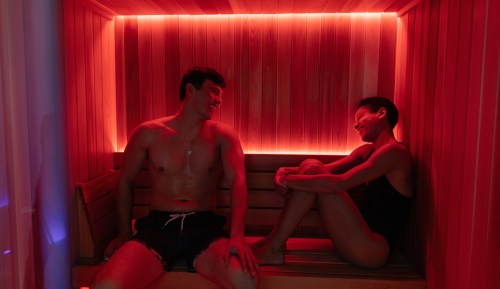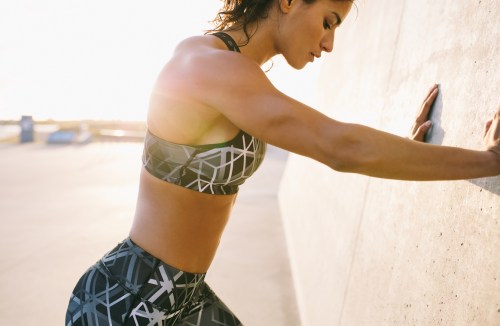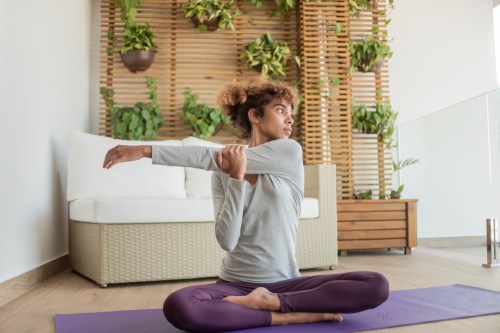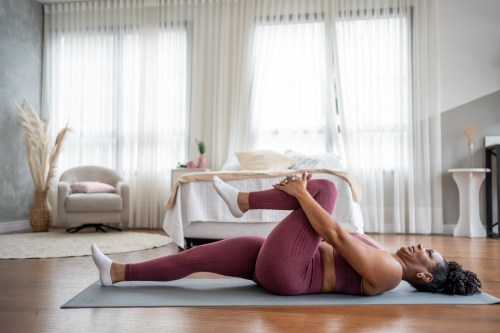These are the 6 stretches you should do after every weight training session
You should always be stretching after weight training, and experts have six stretches you should start with that target both your upper and lower body.

Raise your hand if you check out the second your weight training session is over. Once that final set is complete, you drop the weights and plop on the couch to recover. But just because your workout feels like it’s done, it isn’t, because you haven’t taken the time to do your stretching after weight training.
No matter how heavy or light the lifts, stretching after weight training is always a must for multiple reasons. While it might just seem like something optional to do when you feel like you need it, Toni Melaas, creative director and partner at Outer Reach, says it’s what enables your body to be where it needs to be the next time you pick up those weights.
“Muscles need to ‘breathe’ to work properly. If muscles are taught to contract more than expand—like in most weight training programs—they’re operating at 50 percent of their power, and sooner or later they’ll degrade under that relationship and fail to support the bones and organs they’re tasked with sustaining,” says Melaas. “Dynamic stretch is a natural companion to any weight training routine, offering your muscles a chance to breathe and expand, to improve your blood flow, and strengthen your connective tissue, all the while enhancing your postural alignment and range of motion.”
Aside from keeping your body feeling good and preparing yourself for your next sweat session, Pamela Kalechofsky, certified stretch therapist at Stretch Relief, says stretching after weight training is also key in making sure you’re not feeling stiff and sore the next day. Something that’s not only uncomfortable (and sometimes painful!) to deal with, but can also get in the way of your progress if you allow it to. It’s hard to stick to your lifting schedule when you can barely move your arms.
“Our body produces lactic acid, which can cause our muscles to feel fatigued and achy. Stretching after a workout, during your cool down, can assist in alleviating this,” says Kalechofsky. “In addition, when you stretch once you’re warm, you have more ability to increase your flexibility and reduce your risk of injury, as the body is able to move more freely and let go of any tensions you may be holding onto. It’s especially a great release after the efforts of weight training.”
Be sure you’re stretching after weight training with these options
For your upper body:
Because weight training involves a lot of your upper body, Kalechofsky recommends doing the following three stretches after you’re done with your session.
1. Triceps stretch
- 1.Reach your arm up and place your hand behind your back.
- 2.Use your other hand to assist the stretch of your tricep.
- 3.Hold for 10 seconds.
2. Chest stretch
- 1.Stand in a doorway.
- 2.Place one palm against the wall at a 90-degree angle, keeping your torso parallel. Your elbow should be a little higher than your shoulder.
- 3.Gently lean your body away or take a small step forward to feel the stretch.
- 4.Hold for 10 to 30 seconds then repeat on the other side.
3. Shoulder joint and posterior deltoid stretch
- 1.Stand straight and take your left arm across your chest as straight as you can.
- 2.Use your right arm to hold the back part of your left arm above the elbow.
- 3.Hold for 10 to 30 seconds then switch sides and repeat.
For your LOWER body:
If you’re working your lower body, Melaas recommends using these stretches that offer release for the IT bands, target the hamstrings, open up the low back and hips, and more.
1. Dying warrior
- 1.From all fours, sit on your right hip and straighten your bottom right leg out a 90-degree angle to your torso, flexing the foot with your baby toe side down on the floor.
- 2.Straighten the top leg back in line with your head, placing it on a book or block behind you. Flex your back foot with your big toe side down on the block.
- 3.Bend your elbows into a sphinx position and extend your torso forward out of your hips, as if you’re trying to crawl through the frame of your elbows.
- 4.Carve your abs to the right, away from the bottom leg. Then hug your shoulder blades in and down in the shape of a heart as you broaden your chest forward and up.
- 5.Breathe into this active stretch for 30 to 60 seconds.
2. Side lying quad stretch
- 1.With your top foot on the block behind you, like in the stretch above, bend your bottom leg back behind you at a 90-angle. Maintain the stack of your pelvis with your top hip spinning slightly forward and down.
- 2.Engage your core in and up, creating a little drive-through window between your bottom side belly and the floor to continue to stabilize your pelvis in that stacked position.
- 3.Press your straight bottom arm into the floor for stability and move your bent back knee back behind you until you start to feel your quads stretch. The farther back your knee is from your pelvis, the more stretch you’ll get without having to flex your knee.
- 4.Use your upper arm to grab your back flexed foot and draw it toward the outer bottom pelvic half, continuing to draw your abs in toward your spine and to extend your torso out of your hips. Keep your top hip slightly forward to stabilize your pelvis.
- 5.Stay in this deep, engaged stretch for 5 to 10 slow breaths before breathing in to release your foot.
3. Ankle to knee hip opener
- 1.On your back with your knees bent and feet parallel on the floor, bend your right flexed foot over your left thigh just above the knee, keeping your low back in its neutral curve slightly away from the floor. Engage your core.
- 2.Drop your left knee to your left onto a pillow, taking your figure four shape while keeping both feet flexed.
- 3.Press your straight right arm into the floor and place your left hand on your right knee to plug the right thigh deeper into the right hip socket. Keep your chest wide with your abs hugging into the spine and to the right.
- 4.Maintain the action of your core and the plugging of your thighs consistently for 30 to 60 seconds.
Sign Up for Our Daily Newsletter
Get all the latest in wellness, trends, food, fitness, beauty, and more delivered right to your inbox.
Got it, you've been added to our email list.










